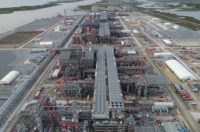The trade war between the United States and China is placing at risk the multibillion-dollar construction market for new liquefied natural gas terminals around the U.S.
At one point, American exports of the superchilled natural gas to China were hailed as a possible way to end the trade imbalance between the two countries. But, on Aug. 3, China said it may place a 25% tariff on U.S. LNG if the Trump administration imposes a threatened $200 billion of tariffs on Chinese products.
"The escalating trade disputes between the United States and China are putting the success of the American oil and gas sector at risk, and stand to deter investments of long-term energy projects," wrote Ed Longanecker, president of the Texas Independent Producers and Royalty Owners Association in an Aug. 23 statement. "With LNG demand expected to rise significantly over the next 12 to 18 months, the possibility of China implementing tariffs on the U.S. natural gas exports has also caused concern about the construction of several facilities in the United States for LNG exports."
If left unresolved, the trade war could imperil the construction of 20 LNG projects in the United States that have been approved or proposed but are not yet under construction. At present, five export terminals are under construction.
In the short term, the U.S. could be shut out of selling to China during the high-demand winter months, Matthew Hong, director of power and gas research at Morningstar, wrote Aug. 22 in a note to clients. He added that PetroChina has already said it may temporarily halt purchases of spot LNG.
"Over the long term, a prolonged disagreement could delay the second wave of U.S. LNG projects from receiving final investment decisions," he continued. "Each of these projects requires some level of base contracting, and this is especially true for projects that depend heavily on third-party financing. While a delay by itself would not kill a specific project, it could prevent developers contracting with potential shippers during the early stages of what is expected to be bull market for LNG over the next two years."
China is the third-largest importer of U.S. LNG, averaging about 283 million cu ft per day in 2017, or about 15% of U.S. LNG exports, according to the Energy Dept. But as more LNG comes online from the terminals under construction, that level had been expected to increase sharply.
Cheniere, with the first online LNG terminal in Corpus Christi, Texas, is still optimistic about the China market, Jack A. Fusco, the company's president and CEO, said in an Aug. 9 second-quarter earnings call. The company inked a long-term deal to sell LNG to China earlier this year. Cheniere's contract with PetroChina supported the financing of a third LNG train at its Corpus Christi facility, which is being built by Bechtel.
"From a high level, our business is a very long-term one, and it is well understood that China needs more LNG over the long term," Fusco said. "We view U.S. LNG as an important variable to help resolve trade issues as U.S. LNG into China is beneficial to both nations. Cheniere, along with our partners and stakeholders, have seen the economic benefits of U.S. LNG into China. [The terminal] represented over a $3-billion investment. … Corpus Christi, and thousands of direct and indirect jobs that project is expected to create."
But Fusco hinted future projects may not be as easy.
"I'm glad that we're through with the $30-billion construction effort, and now we can reap the rewards for that effort," he said. "But there's a lot of headwinds on just infrastructure overall. You've got steel tariffs; you have rising interest rates—and these are very capital intensive projects."





Post a comment to this article
Report Abusive Comment